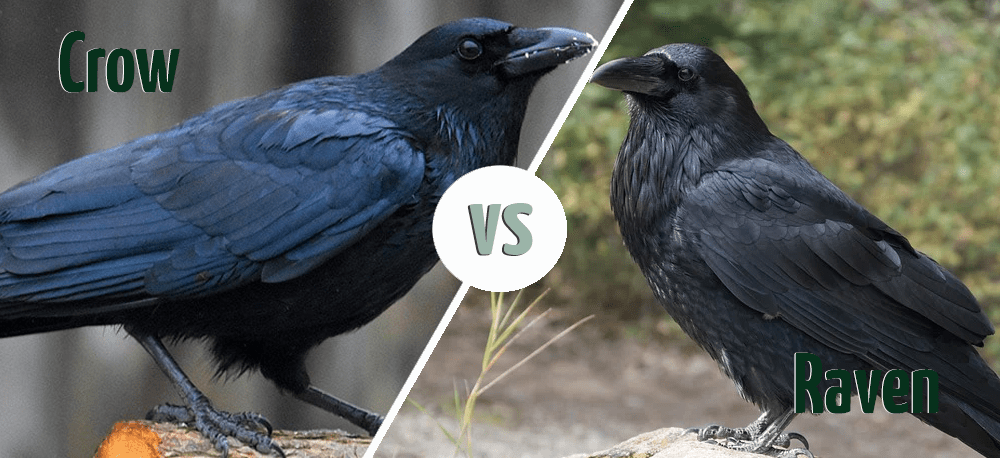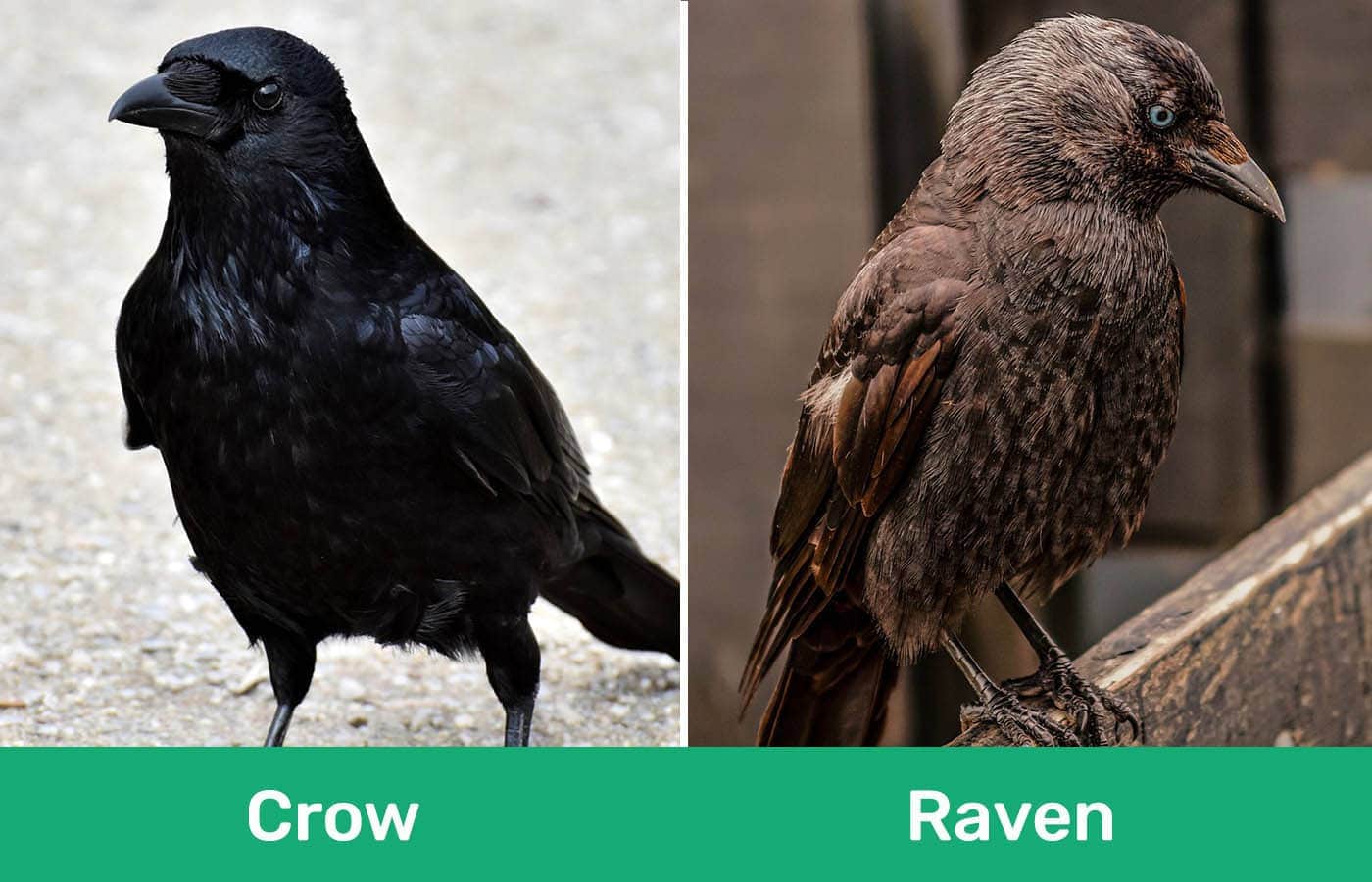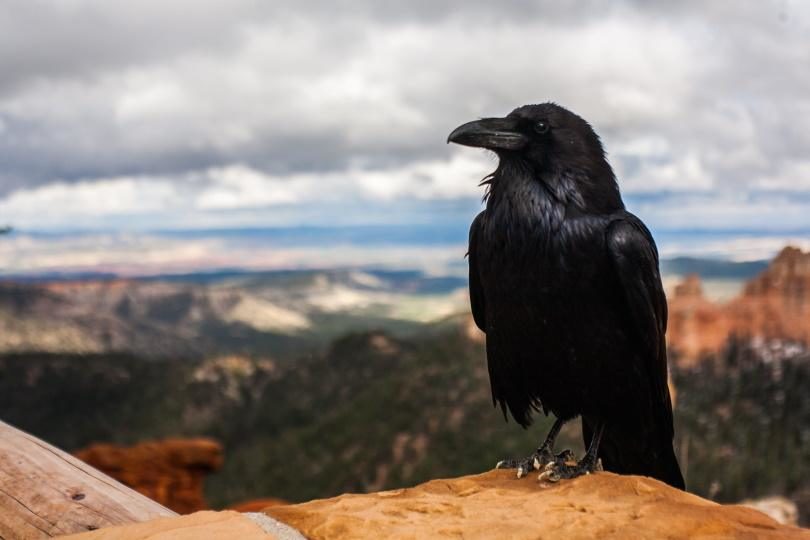Crows vs Ravens: How to Tell the Difference (With Pictures)
Last Updated on

Crows and ravens look extremely similar, and many people have a difficult time telling them apart. Some people even believe they are the same animal with different names in different parts of the world. If you would like to learn how to distinguish these two amazing birds, you’ve come to the right place. We’re about to look at both and discuss size, lifespan, temperament, and more to help[ you be better informed.

Visual Differences

At a Glance
- Average height (adult): 16 – 20 inches
- Average weight (adult): 1 – 3 pounds
- Lifespan: 7 – 8 years
- Tail Length: 8 – 10 inches
- Wingspan: 33 – 39 inches
- Average height (adult): 21 – 26 inches
- Average weight (adult): 5 – 4.4 pounds
- Lifespan: 10 – 15 years
- Tail Length: 10 – 14 inches
- Wingspan: 39 – 59 inches
Crow Overview
Description
The Crow is a large black bird that usually stands between 16 and 20-inches tall. Its wingspan usually ranges from 33 to 39 inches, with iridescent black feathers covering its wings and body. Crows also have a black bill and black feet. Males tend to be larger than females, and they can weigh as much as 3 pounds fully grown. They typically make an easily identifiable “caw caw” sound, but they can also imitate other animals and can produce a wide variety of sounds.

Habitat
Crows are highly adaptable and can live almost anywhere in the United States, and where you might struggle to find the American Crow. Many farmers consider the Crow a pest and take active measures to keep them off their property, including hunting. Despite these measures, the Crow population in the United States is as strong as ever.
Behavior
Crows are social animals that tend to live in large groups, and many experts consider them highly intelligent. They can communicate and react to danger, which is why they are so hard to control, and they can cause considerable damage, eating crops and stealing bird eggs and even baby birds from nests.
Types:
There are several crow species, including the Pied Crow, Little Crow, Cape Crow, Hooded Crow, Indian Jungle Crow, Marijana Crow, and many others. However, the only crows you are likely to find in the United States are the American Crow, Hawaiian Crow, Tamaulipas Crow, and Fish Crow. You can find the American Crow almost anywhere, but the others are only in specific environments.

Raven Overview
Description
The Raven is an extremely large bird, and it is the largest of the passerines, which are perching birds or songbirds. It can often weigh more than four pounds, and it has a slightly curved bill that helps set it apart from the Crow, which has a straight bill. The legs and feet are also larger than other birds, and like the crow, they have iridescent black feathers covering their body. However, unlike the Crow, they have shaggier feathers, especially around the neck, and a wedge-shaped tail that is easy to see when the bird is in the air. These birds do not make the “caw caw” sound of the crow but make a slow, raspy “groonk” sound instead.

Habitat
Like the Crow, the Raven can easily adapt to living in many environments, and you can find them everywhere in Europe, Asia, and Canada. It prefers to live in mountainous regions or along the coast, but you can find them in other areas if there are plenty of tall trees that they can nest in and plenty of open land nearby where they can find food. They also like the coastal areas because the weather is more stable with easy access to food and water.
Behavior
Ravens tend to stay in their hometown throughout the year, moving very little. They tend to spend time in pairs iinstead of larger flocks like Crows, but younger birds may choose to form a flock for a time until they get older. Older Ravens are typically quarrelsome with each other, and it’s not uncommon to see them arguing. However, they are devoted to their families, and mates will work together to raise their young. It has few natural predators, though some owls and other animals may attempt to steal their eggs, and Eagles and Hawks may also attack them occasionally.
Types
Several species of Raven exist, including the North Eurasian Raven, Icelandic Raven, North African Raven, The Northern Raven, The Western Raven, and others. You will likely find only the Northern Raven and Western Raven in the United States in small, specific locations.
- Related Read: How Long Do Crows Live? (Average & Maximum Lifespan)
Are Raven Bigger Than Crows?
Yes, the Ravens are larger than the Crows. Many species of both birds can vary in size considerably. The Raven is almost always larger.
Other Facts
- Crows are susceptible to West Nile, so they are a great bioindicator that can tell us where the disease is active. However, crows cannot transfer the disease to humans.
- Farmers invented scarecrows to keep crows off their property.
- Crows Live in communities called a murder, though most scientists would call it a flock.
- Ravens are acrobatic fliers that often perform tricks like summersaults and flying upside down while in the air.
- Ravens will often work in pairs to obtain food.
- Like Crows, Ravens like to mimic the sounds of other species and can even imitate human words if you raise them in captivity.
- Ravens are scavengers that will eat almost anything, including carrion, while crows will look for other kinds of food before resorting to it.
- Ravens are long revered and are often seen in literature, including The Raven, by Edgar Allen Poe.

Summary
Ravens are quite a bit larger than Crows with a much larger curved beak. It often has shaggy feathers and will make a slow, raspy “groonk” sound instead of the telltale “caw caw” that you will hear from Crows. You will often find Ravens in pairs, and they often quarrel with other Ravens. Crows live in large groups, and you will hear them communicating with each other when you are in their territory.
We hope you have enjoyed reading over this short guide and found the answers you needed. If we have helped you identify the birds around your home, please share this guide to the difference between Crows and Ravens on Facebook and Twitter.
Featured Image Credit: Left – Crow (Image Credit: JackBulmer, Pixabay), Right – Raven (connie_sf, Pixabay)
About the Author Ed Malaker
Ed Malaker is a veteran writer who contributes to a wide range of blogs covering information on computer programming, pets, birding, tools, fitness, guitars, and optics. Outside of writing, Ed is often found working in the garden or performing DIY projects in the house. Ed is also a musician, spending his time composing music for independent films or helping people repair their guitars.
Related Articles:
Monocular vs Telescope: Differences Explained (With Pictures)
How to Clean a Refractor Telescope: Step-by-Step Guide
How to Clean a Telescope Eyepiece: Step-by-Step Guide
How to Clean a Rifle Scope: 8 Expert Tips
What Is a Monocular Used For? 8 Common Functions
How to Clean a Telescope Mirror: 8 Expert Tips
Brightfield vs Phase Contrast Microscopy: The Differences Explained
SkyCamHD Drone Review: Pros, Cons, FAQ, & Verdict
